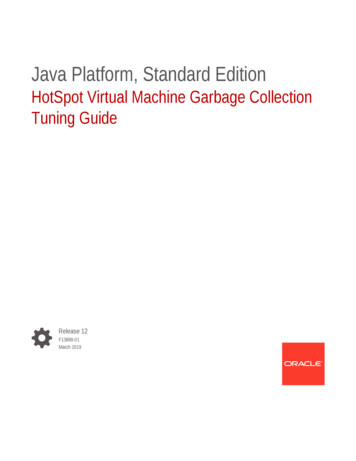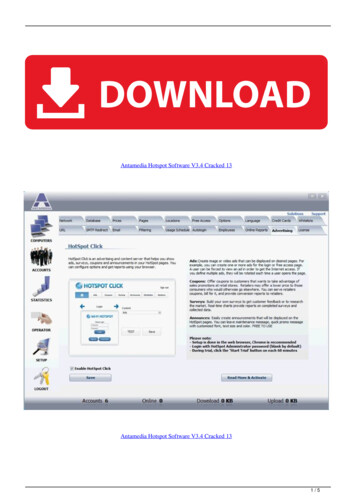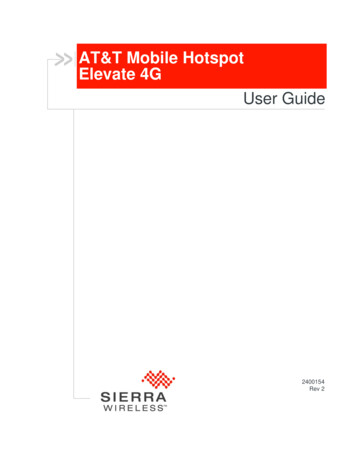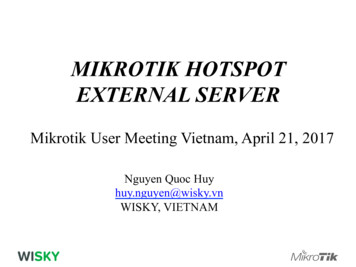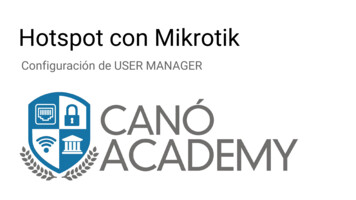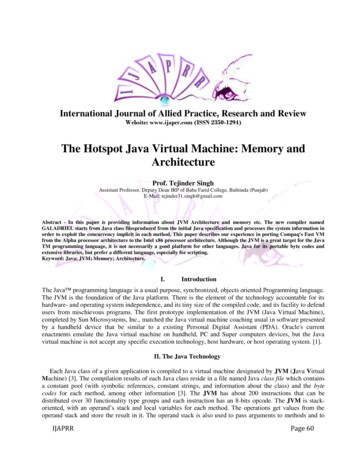
Transcription
International Journal of Allied Practice, Research and ReviewWebsite: www.ijaprr.com (ISSN 2350-1294)The Hotspot Java Virtual Machine: Memory andArchitectureProf. Tejinder SinghAssistant Professor, Deputy Dean IRP of Baba Farid College, Bathinda (Punjab)E-Mail: tejinder31.singh@gmail.comAbstract - In this paper is providing information about JVM Architecture and memory etc. The new compiler namedGALADRIEL starts from Java class filesproduced from the initial Java specification and processes the system information inorder to exploit the concurrency implicit in each method. This paper describes our experience in porting Compaq's Fast VMfrom the Alpha processor architecture to the Intel x86 processor architecture. Although the JVM is a great target for the JavaTM programming language, it is not necessarily a good platform for other languages. Java for its portable byte codes andextensive libraries, but prefer a different language, especially for scripting.Keyword: Java; JVM; Memory; Architecture.I.IntroductionThe Java programming language is a usual purpose, synchronized, objects oriented Programming language.The JVM is the foundation of the Java platform. There is the element of the technology accountable for itshardware- and operating system independence, and its tiny size of the compiled code, and its facility to defendusers from mischievous programs. The first prototype implementation of the JVM (Java Virtual Machine),completed by Sun Microsystems, Inc., matched the Java virtual machine coaching usual in software presentedby a handheld device that be similar to a existing Personal Digital Assistant (PDA). Oracle's currentenactments emulate the Java virtual machine on handheld, PC and Super computers devices, but the Javavirtual machine is not accept any specific execution technology, host hardware, or host operating system. [1].II. The Java TechnologyEach Java class of a given application is compiled to a virtual machine designated by JVM (Java VirtualMachine) [3]. The compilation results of each Java class reside in a file named Java class file which containsa constant pool (with symbolic references, constant strings, and information about the class) and the bytecodes for each method, among other information [3]. The JVM has about 200 instructions that can bedistributed over 30 functionality type groups and each instruction has an 8-bits opcode. The JVM is stackoriented, with an operand’s stack and local variables for each method. The operations get values from theoperand stack and store the result in it. The operand stack is also used to pass arguments to methods and toIJAPRRPage 60
receive the return result from a called method. There are instructions to transfer word contents from/to thelocal variables to/from the operand stack, instructions related to the manipulation and creation of objects,arrays, and the information encapsulated within it, control-flow instruct.III.JVM ArchitectureA Java virtual machine (JVM) is a virtual machine that can execute Java byte code. It is the code executioncomponent of the Java software platform. Sun Microsystems has stated that there are over 5.5 billion JVMenabled devices. In order to write and execute a software program you need the following.1.Editor – To type your program into, a notepad could be used for this.2.Compiler – To convert your high language program into native machine code.3.Linker – To combine different program files reference in your main program together.4.Loader – The loader can be copy files on your hard disk device like Flash Drive, CD into RAM for run.The filling is mechanically done when your run your code.5Execution – Genuine run the program code, if you need is cleared that by your Operating System and CPU.1.1 JVM ArchitectureWhy is Java slow? Dynamic Linking Unlike C, linking is done at run-time, every time the program is run in Java. Run-time Interpreter the conversion of byte code into native machine code is done at run-time inJava which furthers slows down the speed.IV.JVM Memory ArchitectureJVM one of important module of Java architecture and portion of the JRE (Java Runtime Environment).There are provided the annoyed stage functionality to java. It’s a software procedure that transforms thecomplier into Java byte code into machine code. Not a machine code just a byte code is an intermediatelanguage in the middle of Java source and the parent system. Greatest program design language like C andPascal exchanges the basis code into computer language such as machine code for unique detailed style ofinstrument as the machine language differ from organization to organization. Mostly compiler produces codefor a particular system but Java compiler converts a source to machine it’s the structure can be used for avirtual machine. JVM offers security to java.[Type text]Page 61
1.2 JVM Memory 1 Eden Space (heap): The group beginning which memory is initially allotted? For most objects. Survivor Space (heap): The group Containing objects that have continued. The garbage collection of theEden space. Ensured Generation (heap): The pool comprising objects that have existed for some time in the survivorspace. Permanent Generation (non-heap): The pool containing all the reflective data of the virtual machineitself, such as class and method objects. Together Java VMs in order practice class data distribution, presentage group is separated interested in read-only and read-write areas. Code Cache (non-heap): The Hotspot Java VM also contains a code cache, containing memory that is usedfor compilation and storage of native code.1.3 JVM Memory 2The heap that one is separated into three areas: Tenured (also called Old), Young (also called New), andPermanent (Perm). The main motive last this is to type garbage collection more well-organized. Permanentshould never require collection (although you can configure it), Old should be rarely collected, and Youngwill be collected a lot.V.Heap Metrics[Type text]Page 62
So how is the total memory distributed onto the different areas? The JVM offers us to keep track of alot of information on memory via JMX. For example, there is a good command line utility which shows youthe usage of all your spaces.Syntax: jstat -gcutil ProcessID D:\Tejinder jstat -gc 01.4 JVM GCVI.JVM Pros and ConsA virtual machine is a layer of abstraction that gives a program one simplified interface forinteracting with a variety of physical computers and their operating systems. Security:Java virtual machine (VM) is that the virtual machine attempts to verify all programming before itis executed on behalf of various movement and straight thoughtful faults inside a Java code is restricted tothe virtual machine's sandbox. Cross Platform: A tremendous advantage of the Java VM is that it allows a program to be written andcompiled only once, which then can be run on a wide variety of systems and operating systems withoutmodification. Many cell phones and embedded devices include a Java VM. Speed : Since programming must be translated from generic "byte code" to the machine code for the targetsystem as it is being run, it is unbearable for Java to complete as rapidly as languages that can converts intomachine code directly for the goal to systems. Platform Specific Features: Java VM must be execute continuously an extensive variability of systems;structures definite to a single OS are frequently not applied into Java programs. In accumulation, the"appearance and texture" of Java applications can regularly be moderately altered than the evasion styles ofnative applications within an operating system.VII.Future WorkThere are 800,000 lines of C/C code in Sun’s JDK 1.6. We expect Robusta should be able tosandbox most of JDK’s system libraries, as we have demonstrated for zip and libec. However, it is possiblethat not all native libraries for system classes are suitable for Robusta because of restrictions related tofunctionality or performance. Some system native libraries may need direct accesses to the JVM state. Forinstance, a security manager accesses JVM’s method-call stack directly. Some system classes’ native librariesmay cross the boundary between the Java and native worlds so often that putting them into a sandbox wouldhave a significant performance penalty for the JVM; in these cases. On the other hand, it does not preventExploits of vulnerabilities using code snippets already in the code region (e.g., return-to-libc attacks or returnoriented programming). Control-Flow Integrity can foil a large number of attacks that are based on illegalcontrol transfers.VIII.ConclusionI have described the techniques used in order to provide an HW performance acceleration of Javabyte codes. The developed GALADRIEL compiler allows an Efficient front-end to HLS systems startingfrom a system Java specification. Using the Java VM as a propagation vector for distributing dynamiclanguages out to a large audience is a tempting goal. We've examined two difficulties with targeting dynamic[Type text]Page 63
languages to the current Java VM: the overhead of boxing small data structures, and the mismatch betweenthe VM's Java-tuned instruction set and the requirements of dynamic languages. It appears that this extensionshould have no performance impact on current Java programs. Native code has always been the security darkcorner of Java security.IX. References[1] "The Java Virtual Machine SpecificationJava SE 7 Edition", Tim Lindholm Frank Yellin, GiladBracha, Alex Buckley, 2012-0727, JSR-000924 Java Virtual Machine Specification ("Specification") Version: 7, 2011 Oracle America, Inc. and/or its affiliates.[2] Tim Lind Holm and Frank Yellin. The Java Virtual Machine Specification.Addison-Wesley, Reading, Massachusetts, 1996.[3] e-jvm.html[4] architecture.html[5] “Robusta: Taming the Native Beast of the JVM”, Joseph Siefers, Gang Tan, Greg Morrisett, CCS’10, October 4–8, 2010, Chicago,Illinois, USA.[6] “Towards an Automatic Path from Java Bytecodes to Hardware through High-Level”, João M P Cardoso, Horácio C Neto,InProceedings of the 5th IEEE International Conference on Electronics, Circuits and Systems, Lisbon, Portugal, September 7-10, 1998.[7] “The Java Virtual Machine Specification Java SE 7 Edition”, Tim Lindholm, Frank Yellin, GiladBrachaAlex Buckley, 2012-07- 27, Oracle America, Inc. and/or its affiliates. All rights reserved. 500 Oracle Parkway M/S 5op7, California94065, U.S.A.[8] “Design and Performance Analysis of a Distributed Java Virtual Machine”, MinhaiSurdeanu and Dan Moldovan,[Type text]Page 64
enactments emulate the Java virtual machine on handheld, PC and Super computers devices, but the Java virtual machine is not accept any specific execution technology, host hardware, or host operating system. [1]. II. The Java Technology Each Java class of a given application is compiled to a virtual machine designated by JVM (Java Virtual


